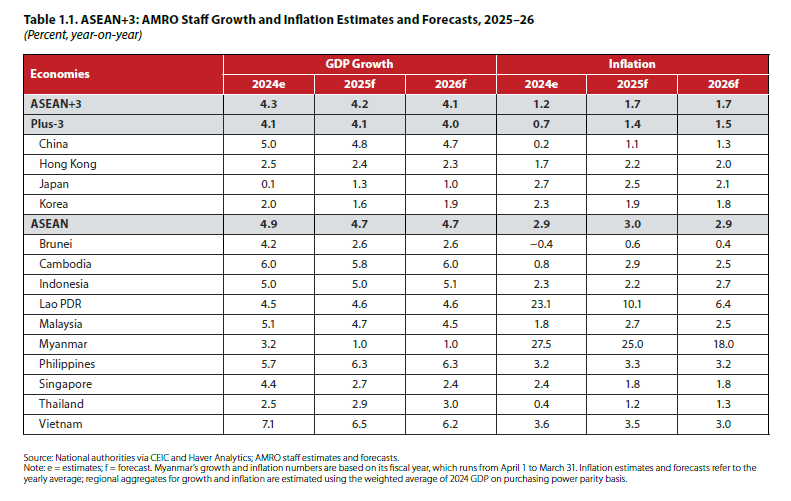
Regional surveillance organization ASEAN+3 Macroeconomic Research Office (AMRO) has forecast that the Philippines may fall short of the government’s lower-end growth target of six percent, casting doubt on earlier projections of it becoming the region’s fastest-growing economy.
Prior to United States (US) President Donald Trump’s imposition of sweeping reciprocal tariffs, AMRO projected Philippine economic growth to remain steady at 6.3 percent amid global setbacks, surpassing regional best performer Vietnam’s 6.2-percent growth by 2026.
Although the numbers have still not been crunched, AMRO group head and principal economist Allen Ng said during a virtual press conference on Tuesday, April 15, that domestic growth will be “negatively affected” by Trump’s tariffs and “likely will fall below six percent.”
He clarified that AMRO will be updating its baseline in the coming months “given the fluidity of the situation.” As of now, it has revised down its forecast by looking at the most recent tariff developments, including the across-the-board reciprocal tariffs and their three-month pause.
AMRO chief economist Hoe Ee Khor noted that the Philippines, being a service-driven economy with a smaller manufacturing sector than other Association of Southeast Asian Nations (ASEAN) countries, is less exposed to tariff impacts.
Semiconductors, which are among the country’s top goods exports, are also exempted from tariffs, further reducing the overall effect. However, Khor said AMRO has also “shaved down the growth of the Philippines,” citing lingering trade risks.
“The Philippines will be affected much less than other countries in the region. Its strength lies in the service industry—especially in BPO [business process outsourcing],” Khor said.
Moving forward, Khor sees that the strength of the local economy will lie on knowledge process outsourcing (KPO), which he thinks is rooted in the country’s strong knowledge base.
Given this, tariff-saturated global trade uncertainties will not inflict serious injury on the Philippine economy.
“We think that the Philippine economy generally will emerge from this tariff war quite well,” Khor said.
Pre-tariff forecasts
Although growth was weaker-than-expected in 2024, AMRO projected that the Philippine economy would accelerate by 6.3 percent in 2025, still trailing behind Vietnam’s 6.5 percent growth.
Last year, AMRO projected the Philippine economy to expand faster at 6.5 percent, matching its forecast for Vietnam.
Over the next year, however, Vietnam will have a lackluster performance at 6.2 percent, while the Philippines will retain its speed, according to the think tank’s latest’s ASEAN+3 Regional Economic Outlook (AREO).
After ranking second previously, the Philippines is set to become the fastest-growing economy in the ASEAN region in 2026.

AMRO was overly optimistic regarding the Philippine economy’s performance last year, which it expected to expand also by 6.3 percent, making it the fastest among ASEAN economies. It expected Vietnam to rank third at six percent, behind Cambodia’s 6.2 percent.
However, Philippine gross domestic product (GDP) growth stood at 5.7 percent in 2024, way below the government’s downscaled target of six to 6.5 percent.
Despite the shortfall, Philippine GDP growth posted a faster movement than the 4.9-percent expansion of the region. Average growth in the region is seen to slow to 4.7 percent in 2025 and 2026.
AMRO’s projected growth for the Philippines falls within the lower end of the government’s more ambitious target of six to eight percent. The Marcos administration’s wider growth target range for the year had taken into account “more uncertain” domestic and global risks.
Over the next 15 years, the Philippines, which AMRO categorizes as a middle-stage economy, is seen to grow about 3.5 percent.
“One of the key factors that could actually improve the Philippines' potential growth is productivity,” Ng said. He said boosting productivity through better infrastructure and tech-driven sectors will be the driver of growth amid rapid technological changes.
Inflation
As for consumer prices, AMRO raised its 2025 inflation forecast from 2.9 percent to 3.3 percent but projected a slight slowdown to 3.2 percent in 2026.
Local inflation would be higher than the projected three-percent regional average in 2025, and 2.9 percent in 2026.
In 2024, inflation averaged 3.2 percent, falling within the upper half of the government’s target band of two to four percent.
In the first quarter of 2025, the average inflation rate stood at 2.2 percent, comfortably within the government’s target band of manageable price increases conducive to economic growth.